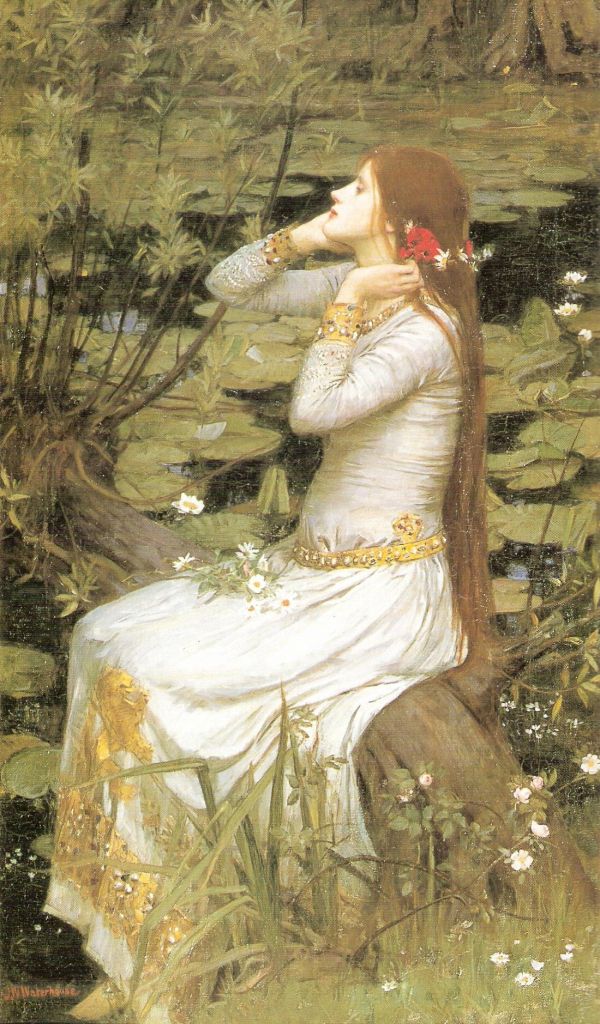
Ophelia (1894)
So, while searching for images inspired by Hamlet, I came across this painting of Ophelia by John William Waterhouse.
Apparently, it is not his only painting of Ophelia, as he has, at the very least, two others. One made in 1889 and the other in 1910.
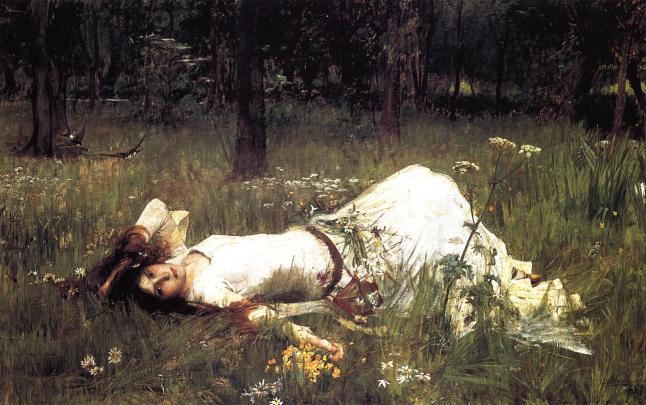
Ophelia (1889)
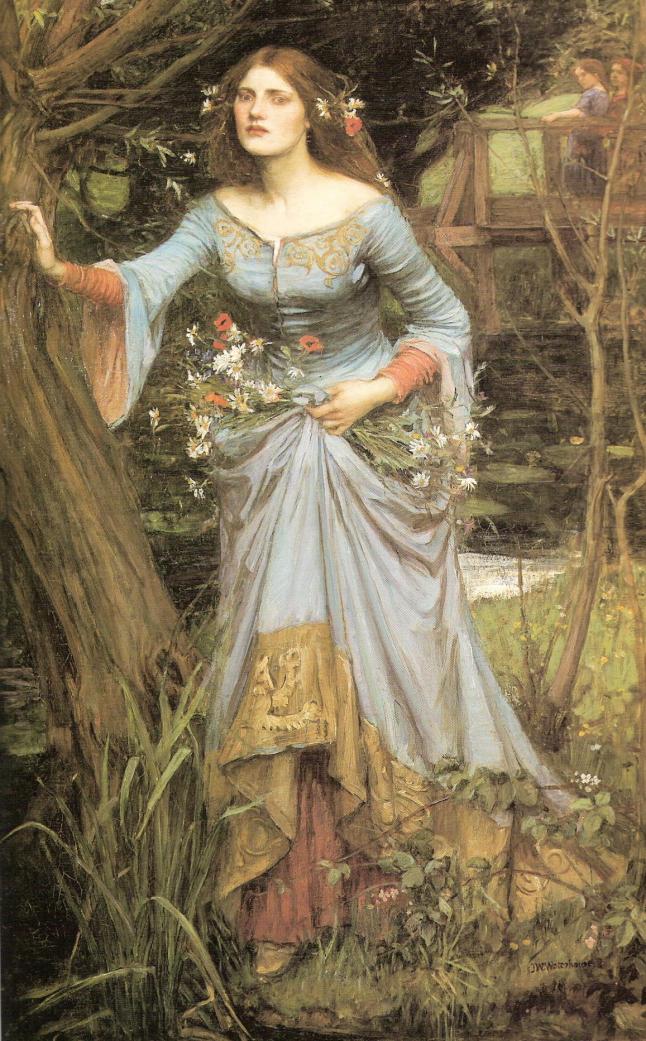
Ophelia (1910)
There is a third that is called Gather Ye Rosebuds, which may or may not be a study of Ophelia as well.
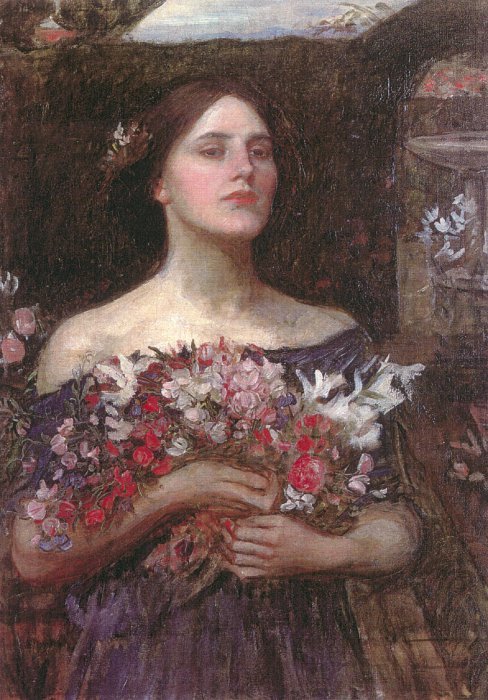
Gather Ye Rosebuds or Ophelia (a study) (1908)
I will be mostly speaking about the first painting in this post, but I thought it was interesting that he had so many different interpretations. (My source for the above was Wikipedia 😉 )
So, this painting (see right to refresh your memory 🙂 ) 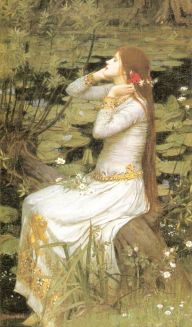 appears to depict Ophelia before her death, described by the words:
appears to depict Ophelia before her death, described by the words:
There is a willow grows askant the brook
That shows his hoar leaves in the glassy stream:
Therewith fantastic garlands did she make
Of crowflowers, nettles, daisies, and long purples,
I know that the quote kind of cuts off… but, I thought this excerpt best fit the image that Waterhouse depicted in his painting. Although, cornflowers, daisies, and nettles seem to be what most of her garlands are made of. I really don’t see any long purples.

long purples

nettles

crowflower?
Okay, to be honest I’m not entirely sure which flower is supposed to be a crowflower, but I think that the picture I found is the safest bet, so I went with it.
I left out a picture of a daisy since they are a pretty common symbol/image/flower used nowadays in pretty much everything you can think of. (Example: typical bouquets/gift baskets, as a cute/girly image for marketing products, etc.)
The exact medium of this painting is oil on canvas, and I believe it is held in a private collection at present, but my sources (the Internet, all-powerful and all-knowing) could be wrong (I didn’t check to see when the information was last updated).
I read somewhere on the World Wide Web that his three paintings of Ophelia represent the events leading up to her death (her youth, when she was in love, and when she went insane), so that might point towards why each painting seems to be an almost completely different interpretation of Ophelia and what she is supposed to be like.
Anyway, I like Waterhouse’s depictions of Ophelia because he emphasizes her close relationship to nature and flowers, making her a much more interesting character than if you just read the play without analyzing it (which makes her seem much more bland). In fact, I didn’t quite realize her connection with nature until after I saw all three of these paintings together.
Also, you know how Hamlet’s famous “to be or not to be” speech is supposed to be about him contemplating suicide? Well, looking at this painting one way, it almost seems like Ophelia is going through the same thing with her aloofness and separation from the rest of the world. Looking at it another way, it might seem like Ophelia’s eventual fate (if you believe she committed suicide) was because of a loss of her will to live after her father was killed by Hamlet, who was supposed to love her and whom she may or may not have loved. And her aloofness in the painting is not caused by her contemplating her demise, but about her contemplating her love for Hamlet, or even her following through with her brother and fathers’ requests for her to stay away from him.
If you do not believe she committed suicide, but rather fell into the water by accident during her madness, this scene explains why she would have been there in the first place: because it was a favorite place of hers to rest and maybe enjoy the scenery, to be at peace. Maybe it even calmed her down to be there. (See? Nature.)
If you do not believe she committed suicide and do not believe she was really crazy, this scene could depict her moments before she died and it may have been that she was pushed in to the water (murdered) by Horatio (who was sent to watch her by Claudius) or even Claudius himself because they viewed her as a hindrance. They may even have knocked her over the head first, which would explain why, if she was not truly insane, she was unable to save herself before she drowned.
Another option is that her food was poisoned, which led to her falling into the water. After all, I’m sure all of us who have read Hamlet are very aware of Claudius’ love for poisons. Claudius may even have foreseen that it would enrage Laertes (her brother) further, and took steps to ensure that Ophelia would not survive long after her father’s death.
I say all this, but it’s all pure speculation. Since Ophelia’s death is not explicitly explained in the play, all of these are equally possible in my mind, and there are even more possibilities that I have left unexplored. In the end, it all comes down to which scenario you choose to believe.
